
| FAMSI © 2005: Blanca E. Maldonado |
||
|
Tarascan Copper Metallurgy at the Site of Itziparátzico, Michoacán, México Project Background and Goals The archaeological site of Itziparátzico is located between the communities of Santa Clara del Cobre and Opopeo, about 10 km south of the Pátzcuaro Basin, in the state of Michoacán (Figure 2). Although previous archaeological investigations in the region had concentrated in the vicinity of Lake Pátzcuaro, particularly in the Tarascan capital of Tzintzuntzan, it is well known among the older coppersmiths of Santa Clara that many mounds or mogotes, lie buried in this area. Presumably, Itziparátzico, as well as several other Tarascan village communities in the Pátzcuaro Basin, specialized in metallurgical craft production during the Late Postclassic period (Horcasitas de Barros 1981; Pellicer 1996). According to colonial sources (e.g. Quiroga 1533, in Warren 1968), the indigenous populations of this region were skilled and knowledgeable in working copper. Itziparátzico and several other Tarascan village communities in the vicinity are mentioned in Colonial sources as communities specialized in metallurgical craft production (e.g. Horcasitas de Barros 1981; Pellicer 1996). The Spanish, eager to exploit the mineral wealth of the area, founded the village of Santa Clara De Los Cobres (modern Santa Clara del Cobre) to foster the processing of metal ore. In 1540, a large forge was built to smelt copper ore, which incidentally is not found locally, but has to be imported from copper mines around La Huacana, 80-100 km to the southwest in the Tierra Caliente (see Figure 3). Quiroga (1533, in Warren 1968) points out that since the smelting of ore took three times as much charcoal as ore; it probably resulted more economical to transport the ore from the mines to the source of charcoal than the other way around. Preliminary surface survey at Itziparátzico during the summer of 2002 confirmed the presence of Prehispanic mounds, domestic terraces, and evidence for metalworking at the site (Figure 1). Evidence for metalworking consisted mostly of slag (locally known as querenda) located in discrete concentrations across the site. The local inhabitants have also described forged and hammered copper objects, such as axes, masks, and tweezers, that have been recovered from agricultural fields that now cover the site. Previously, Efrain Cárdenas (1986) had reported the existence of three archaeological sites at Itziparátzico, which he named separately as Potrero La Cornejalera, Puente del Rebocero, and Opopeo. The research design of the Santa Clara 2004 project was a multi-method approach to identifying and examining traits, or clusters of traits, associated with different stages of metallurgy. The aim was to establish the basis for comparing archaeological evidence for metallurgical production with descriptions of Prehispanic metallurgy found in ethnohistoric sources, involving both the technology and organization of production. These results would also provide an opportunity to compare Prehispanic, as opposed to Contact metal production. The first stage of field research produced a comprehensive map of Itziparátzico, within which all evidence of craft metallurgy on surface has been located. Production areas have been identified mostly from concentrations of slag. Data recovered from excavation are currently being used to determine: (a) the production activities carried out at the locale (smelting, artifact casting, percussion shaping, finishing, etc.); (b) the technology employed in metallurgical production; (c) the context of production (domestic, non-domestic, etc.); (d) the size and layout of the production area; and (e) the relative chronology of the unit. |
||
|
Text links to all pages at this site are available at the FAMSI INDEX |
||

